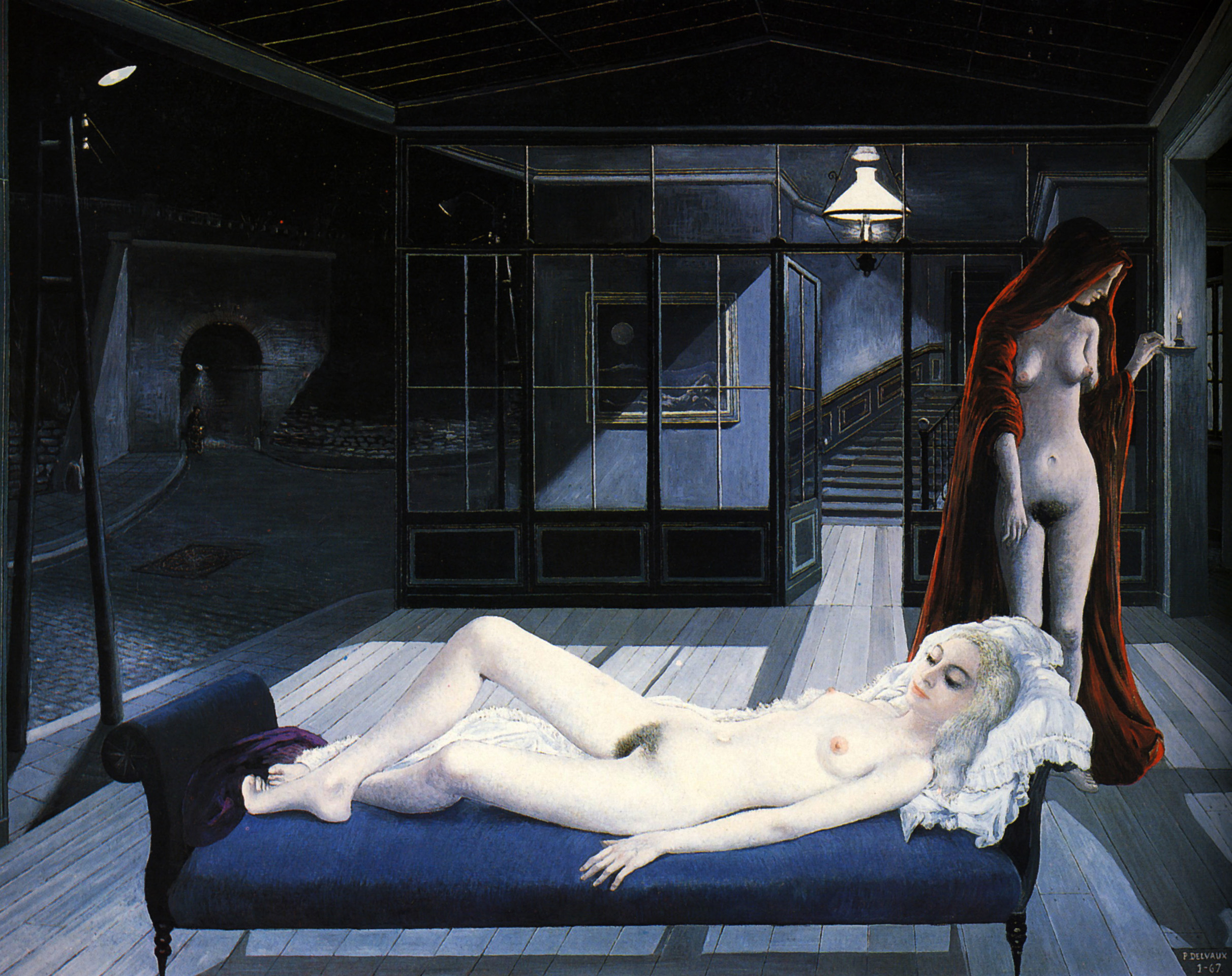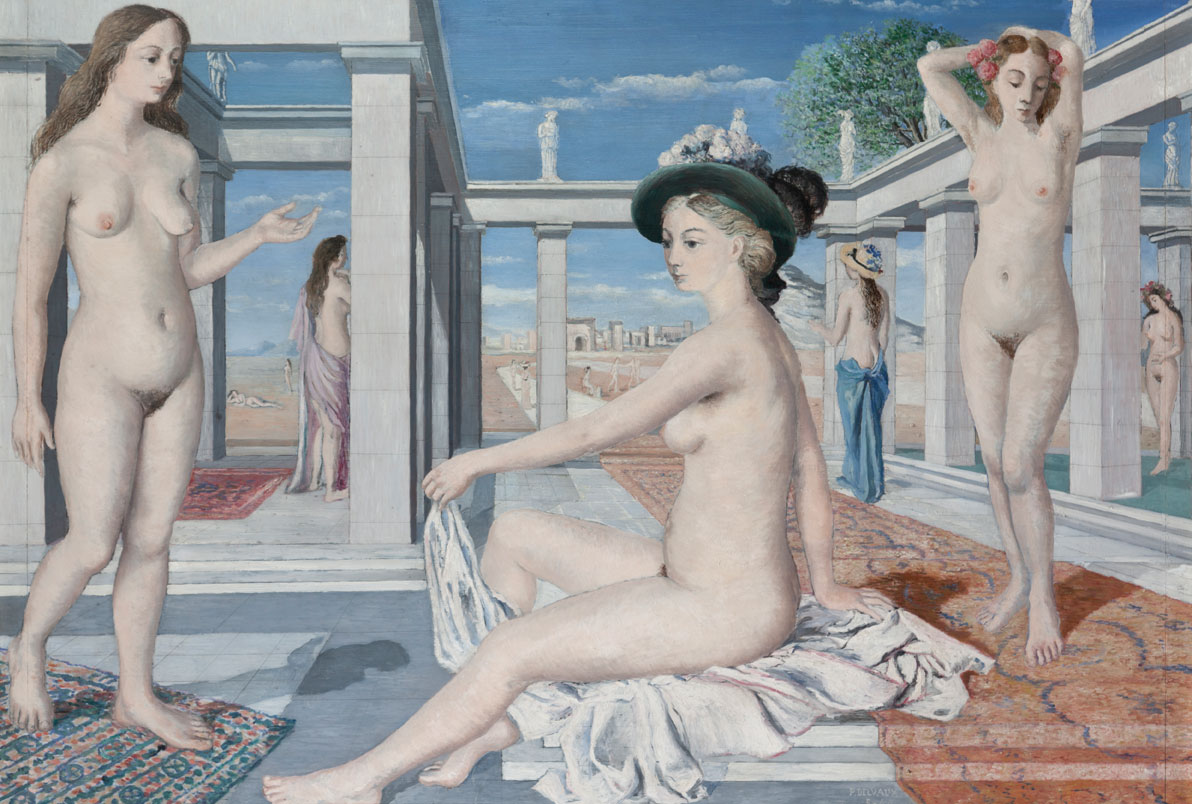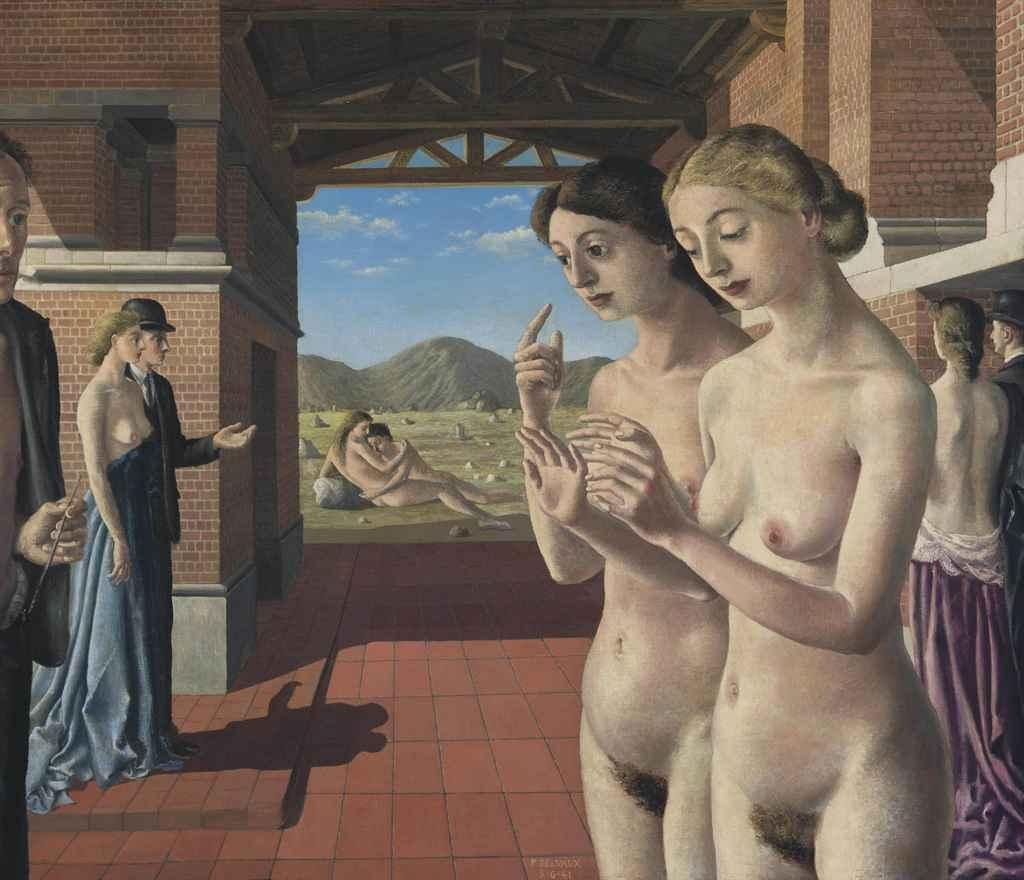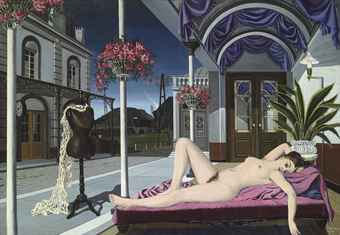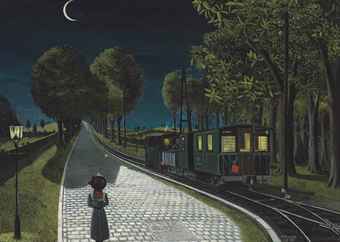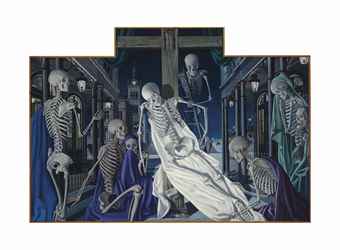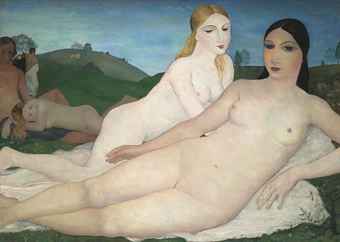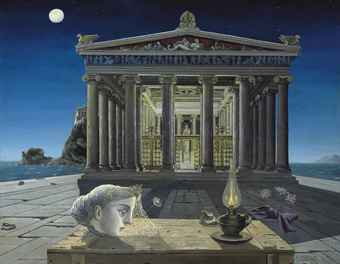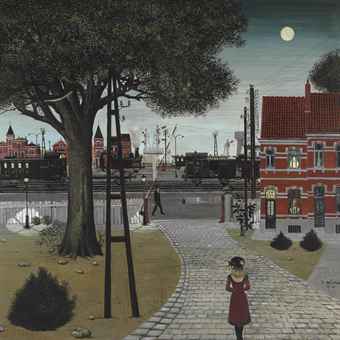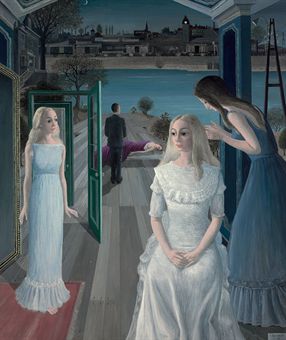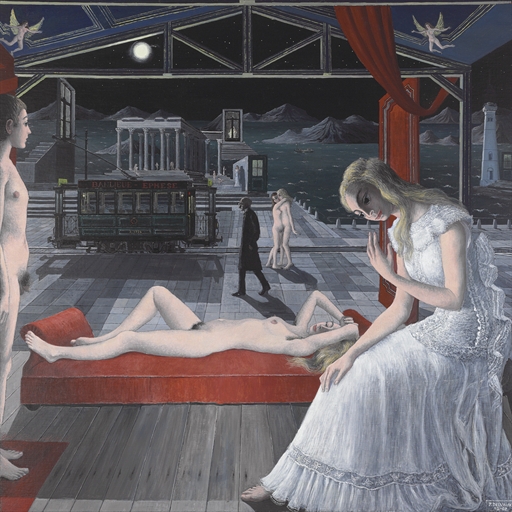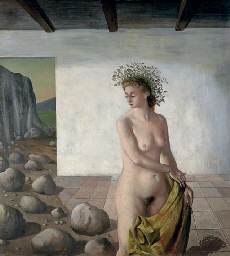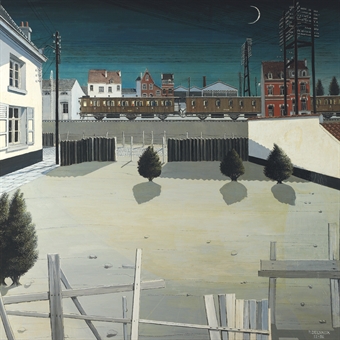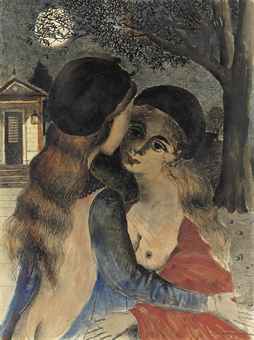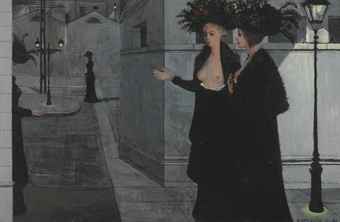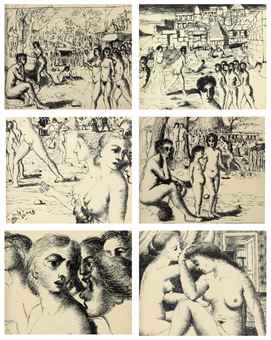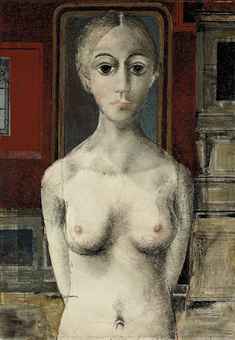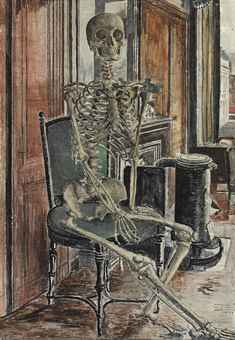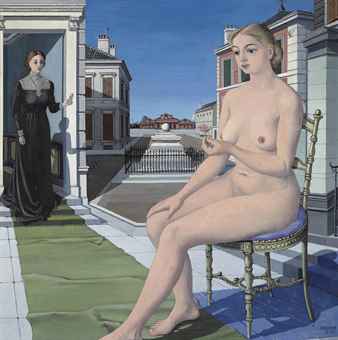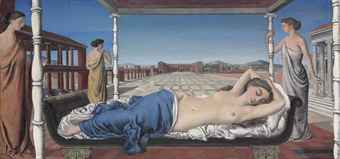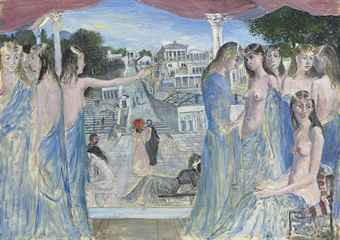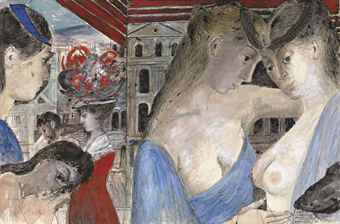Paul Delvaux
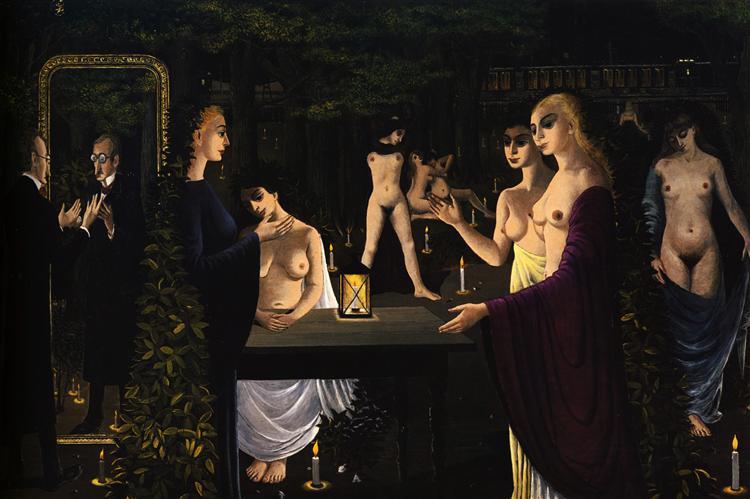
Le Sabbat (The Sabbath) by Paul Delvaux (1962, estimate: £1,500,000 - 2,500,000), one of the most important paintings from the second half of the artist’s career, is being offered by the artist’s family. In many ways Delvaux’s Le Sabbat can be seen as a painterly invocation of the night, the subject that had preoccupied the artist and sustained the mysteries of his art from the 1930s onwards. Delvaux takes the traditional North European subject of Walpurgi snacht or the Witches’ Sabbath and transforms it into a strangely erotic and rather genteel midnight garden party taking place near a railway junction in a suburb of Brussels.
Paul Delvaux
Filles au bord de l’eau
oil on canvas
Painted in 1966.
Estimate: £1,700,000-2,200,000
Giving a
glimpse into Delvaux’s fantastical imagination, Filles au bord de l’eau is
an alluring and sophisticated example of his Surrealist creation – bringing
together the key elements that defined the artist’s mysterious works.
This dream-like scene depicts at once an interior and exterior setting, as architectural elements such as the blue door, mirrors and window frames suggest the conventional structure of a house even as the walls have dramatically opened onto an impressive seascape. The principal protagonist defines the atmosphere of the painting as one of stillness and expectation, with her expressionless gaze and lingering hand gesture directed outside of the composition.
The nude women that surround her recall the gentle beauty of a Botticelli, adding a
This dream-like scene depicts at once an interior and exterior setting, as architectural elements such as the blue door, mirrors and window frames suggest the conventional structure of a house even as the walls have dramatically opened onto an impressive seascape. The principal protagonist defines the atmosphere of the painting as one of stillness and expectation, with her expressionless gaze and lingering hand gesture directed outside of the composition.
The nude women that surround her recall the gentle beauty of a Botticelli, adding a
sense of timelessness to the scene. Throughout his lifetime, Delvaux refused to provide any sort
of narrative for his compositions – stating ‘these figures recount no history: they are’ - leaving the viewer to contemplate the perplexing scene.
![Image result for [[["xjs.sav.en_US.BuG9CZeYrCc.O",5]],[["id","type","created_timestamp","last_modified_timestamp","signed_redirect_url","dominant_color_rgb","tag_info","url","title","comment","snippet","image","thumbnail","num_ratings","avg_rating","page","job"]],[["dt_fav_images"]],10000]](http://www.artnet.com/WebServices/images/ll00059lld34kFFgPNECfDrCWvaHBOcUKG/paul-delvaux-le-miroir.jpg)
- Paul Delvaux’s Le miroir sold for £7.3 million in February 2016
Christie's 2017
Two works are being offered by The Art Institute of Chicago. Paul Delvaux’s Le village des sirènes, created in 1942, one of the best years in Delvaux’s oeuvre, at the very height of the German occupation of Belgium, portrays an otherworldly scene, in which a group of elegantly dressed women sit along a gently curving street with mermaids swimming beyond. The silence conveyed offers a startling contrast to the chaos of the war that was raging in Europe at this time while the disconcerting and anachronistic architectural juxtapositions and disquieting atmosphere reveal a strong affinity with the art of Giorgio de Chirico.
Sotheby's 2016
Paul Delvaux Le Miroir (1936) Estimate: £5,500,000-7,500,000
In this monumental painting Delvaux presents an encounter of disparate elements, juxtaposed in such a way as to create a world of mystery. Depicting at once an interior and an exterior setting, there is an ambiguity in the relationship between the two figures. The nude woman is associated with nature and beauty, whilst the decaying room with its peeling wallpaper may well serve as a metaphor for the woman’s spiritual state. The first owner of Le Miroir was Sir Roland Penrose, who was himself a painter as well as a friend of many Surrealist artists and an avid promoter of their work.
Sotheby's SURREALIST ART EVENING SALE 03 FEBRUARY 2015
Le Train Bleu or La Rue Aux Tramways
Oil on board 122 by 244cm; 48 by 96in.
Painted in November 1946 Est. £2.5 - 3.5 million
Painted in November 1946, Paul Delvaux’s monumental work Le train bleu, alternatively known as La rue aux tramways, is one of the most important and remarkable paintings from the peak of his career. Although the artist was acquainted with the leading figures of the Surrealist group, including André Breton and Paul Eluard, his form of Surrealism remained unique. Capturing the modernity of the urban landscape juxtaposed with the sensuality of the nude form, this monumental work is an exceptional example of the paintings he was producing at this critical time in his oeuvre.
Replete with some of the artist's most iconic motifs, Le canapé bleu embodies Delvaux's aesthetic magnificently (est. $3.5/5 million). Luxuriating nudes play out an ambiguous narrative in the
foreground while the background provides an ineffable sense of place. The setting seems to
oscillate between a cinematic stage set, a domestic space and a train station. The train -
an element that appears in many of Delvaux's works - is only hinted at through the tunnel and red light at the upper left corner of the composition. The viewer is left with an eerie
feeling of erotic anticipation and excitement - a sensibility that pervades many of his earlier compositions as well, including
Les cariatides from 1946, sold by Sotheby’s in May 2011.
Sotheby’s
London Surrealist Art Evening Sale on 5 February 2013
Painted
in 1941, Les Courtisanes (est. £1-1.5
million)is an exceptional example of Paul Delvaux's painting. As in his finest
compositions, it combines the motif of mysterious female nudes placed against a
classically inspired architectural backdrop. Demonstrating the influence on
Delvaux of Cézanne - in the composition, spacing and individual poses of the
nudes, and in the overall concept of a bathing scene - the painting depicts the
figures on a balcony by the sea, dominated by the large sky. The nudes and
semi-nudes that we see before us in the guise of bathers by the sea are no
doubt the courtesans referred to in the title of the work.
Sotheby's 2015
Paul Delvaux
LOT SOLD.
60,000 GBPSotheby's 2014
LOT SOLD. 80,500 GB
Estimate
 1,000,000
—
1,500,000 GBP
1,000,000
—
1,500,000 GBP
 1,000,000
—
1,500,000 GBP
1,000,000
—
1,500,000 GBP
Les Mains
PRICE REALIZED
$6,578,500
Le nu et le mannequin (Le nu au mannequin)
PRICE REALIZED
£3,401,250
Le vicinal
PRICE REALIZED
£2,729,250
Ecce homo (La descente de croix)
PRICE REALIZED
Jeunes filles à la campagne
PRICE REALIZED
£1,609,250
Le temple
PRICE REALIZED
£1,609,250
Le passage à niveau
PRICE REALIZED
$1,538,500
Le sacrifice d'Iphigénie
PRICE REALIZED
$1,314,500
Le rendez-vous d'Ephèse
PRICE REALIZED
£657,250
La veillée
PRICE REALIZED
£580,000
Faubourg
PRICE REALIZED
$485,000
Les demoiselles de Tongres
PRICE REALIZED
£289,250
Christie's 2011
Paul Delvaux (Belgian, 1897 - 1994)
The Belgian artist Delvaux studied architecture and painting in Brussels. He experimented with painting in an expressionist style but turned to Surrealism after seeing a surrealist exhibition in 1934. Delvaux was not a formal member of the surrealist movement and did not participate in group activities. However, he was well respected by the members of the group, including its leader André Breton. Delvaux's style changed little from the 1930s until his death in 1994. His characteristic works consist of nude or semi-nude women (similar or identical in appearance) in inappropriate or fantastical settings. Skeletons and trams are two of the recurring motifs in Delvaux's paintings.L'Appel de la Nuit [The Call of the Night] 1938
This is an early and important work in Delvaux's dream-landscape
style. There is a deliberate conflict between the eroticism of the nudes
and the uninviting setting into which they have been cast. Sexual
fantasy collides with sexual anxiety in the strange and desolate
landscape. The symbolism calls for interpretation but resists any. A
skull and skeleton can be seen in the background, as well as groups of
rocks which appear to be arranged in a prehistoric or symbolic manner.
The rampant vegetation clinging to the languid nudes threatens to engulf
them.
La Rue du tramway [Street of the Trams] 1938 - 1939
This painting is typical of Delvaux's style, featuring enigmatic nude
figures in a strange setting, lit by an eerie, unreal light. Delvaux had
trained in Belgium as an architect, and the backgrounds of his
paintings frequently feature classical architecture or buildings from
Brussels. Trams are a recurring motif in his paintings: a classic sexual
metaphor, according to the psychologist Sigmund Freud. Delvaux probably
used the tram and the expressionless women displaying themselves in
windows and doorways, to suggest sexual tension. Male figures appear
much less frequently in his paintings.
Nu au jardin [Nude in the Garden]
1966
The main figure in this drawing is Danielle Caneel, who modelled for
Delvaux from 1966, the year this work was made. Caneel inspired much of
Delvaux's work of the late 1960s and 1970s. Her slim figure and blond
hair contrast with the stockier, dark-haired women who appear in the
artist's earlier works. The device of presenting figures in an
architectural setting is found throughout Delvaux's work. Here, the
arches in the background act as a framing device for the figures. An
inscription in the bottom corner notes that the drawing was made in
St-Idesbald. Delvaux spent much of his time in the Belgian town from the
1950s and it is the location of the Paul Delvaux museum.




